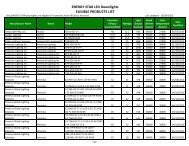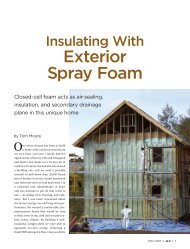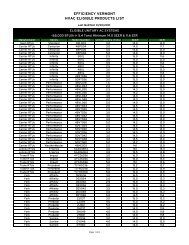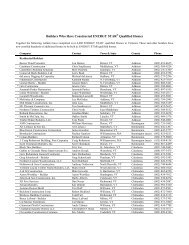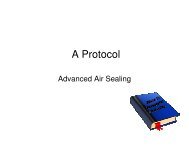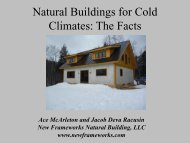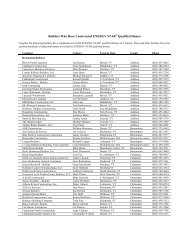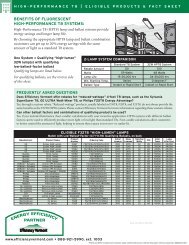Infrared Camera & Envelope Systems pdf - Efficiency Vermont
Infrared Camera & Envelope Systems pdf - Efficiency Vermont
Infrared Camera & Envelope Systems pdf - Efficiency Vermont
You also want an ePaper? Increase the reach of your titles
YUMPU automatically turns print PDFs into web optimized ePapers that Google loves.
l Sick-building syndrome<br />
When buildings are too tight or too moist, health-related<br />
problems quickly come to the forefront. Grouped<br />
together as “sick building syndrome,” these can stem from<br />
inadequate HVAC performance, moisture trapped in walls,<br />
mold growth on cold, damp surfaces and inadequate<br />
air change rates. Many of these can be visualized and<br />
diagnosed, at least in part, with thermography to help<br />
solve these very serious—and common—problems.<br />
Diagnosing these problems is often a very complex<br />
process and, given the fact that litigation may be involved,<br />
it is not something to be entered into lightly.<br />
l Facade delaminations<br />
A great deal of work has been done in SE Asia inspection<br />
the facades of large buildings for delaminations. Failures<br />
of these materials can result in serious personnel injury.<br />
The masonry tiles used to face the buildings tend to<br />
change temperature rather quickly when they begin<br />
to delaminate compared to the underlying structure to<br />
which they were affixed. The diurnal cycle is typically the<br />
driving heat source and inspections are best done in the<br />
early evening hours after a warm sunny day.<br />
l Roof moisture inspections<br />
The inspection of flat roofs, especially built-up roofs (BUR)<br />
has been proven for a number of years. The technique<br />
allows for the detection of moisture trapped in a roof<br />
system; over time this moisture leads to the pre-mature<br />
degradation of the roof. The moisture appears warmer<br />
at night after a sunny day due to its greater thermal<br />
capacitance.<br />
The roof surface must be dry and the technique works<br />
best on roofs with absorbent insulation. Inspection work<br />
can be accomplished either in a roof-top survey or an<br />
aerial survey conducted from a helicopter or fixed-wing<br />
craft.<br />
l Standards and references<br />
Several important standards exist to support the work of<br />
thermographers conducting building inspections. These<br />
include, among others, the following:<br />
– ASTM C 1060-97 Practice for Thermographic Inspection<br />
of Insulation Installations in <strong>Envelope</strong> Cavities of Frame<br />
Buildings<br />
– ASTM C-1153-97 Practice for the Location of Wet<br />
Insulation in Roofing <strong>Systems</strong> Using <strong>Infrared</strong> Imaging<br />
– ISO 6781 Thermal insulation, qualitative detection of<br />
thermal irregularities in building envelopes, <strong>Infrared</strong><br />
Method<br />
– American Concrete Institute Design Standard 530 /<br />
American Society of Civil Engineers Standard 5, Masonry<br />
Building Code and Specification<br />
Another excellent reference, although not a standard,<br />
is the Canadian General Standards Board Manual for<br />
thermographic analysis of building enclosures (149-<br />
GP-2MP). Numerous building related papers have been<br />
published over the years; many are collected on a CD-ROM<br />
from SPIE, entitled Selected Papers from the Proceedings<br />
of Thermosense, edited by John Snell and Doug Burleigh,<br />
available from www.spie.org.<br />
l Qualifications of the thermographer<br />
Although building applications may appear simple,<br />
successful use requires qualified personnel with related<br />
experience. Both training and experience are essential.<br />
An intimate knowledge of construction techniques,<br />
practices, materials, and failures is also important. It is<br />
also not unusual for the thermographer to work with<br />
other building scientists who have expertise in other<br />
areas. Failure to conduct an inspection in a professional<br />
manner can result in serious damage to the building and/<br />
or harm to the occupants.<br />
Image 10: The wet insulation in the roof system shows up<br />
clearly due to its greater thermal capacitance.<br />
Image 11: During the commissioning of this building<br />
thermography revealed an extreme problem involving<br />
exfiltration through the soffit. Courtesy Phil McMullen.<br />
© 2008 The Snell Group / www.thesnellgroup.com



